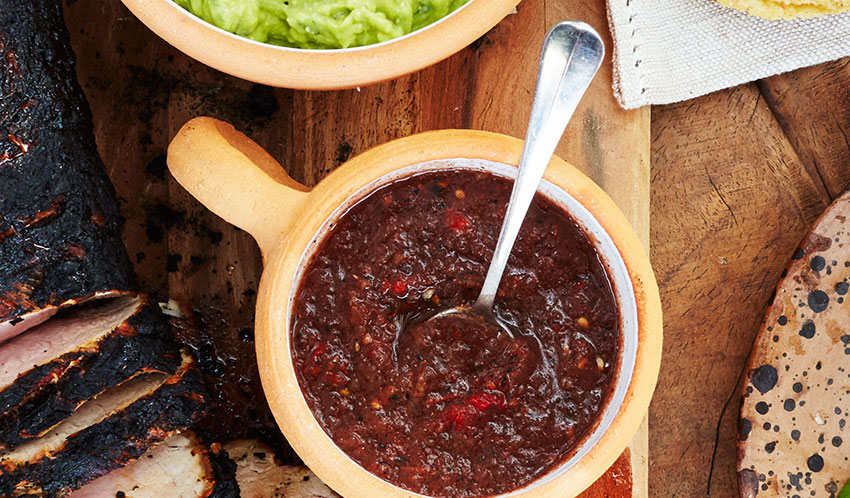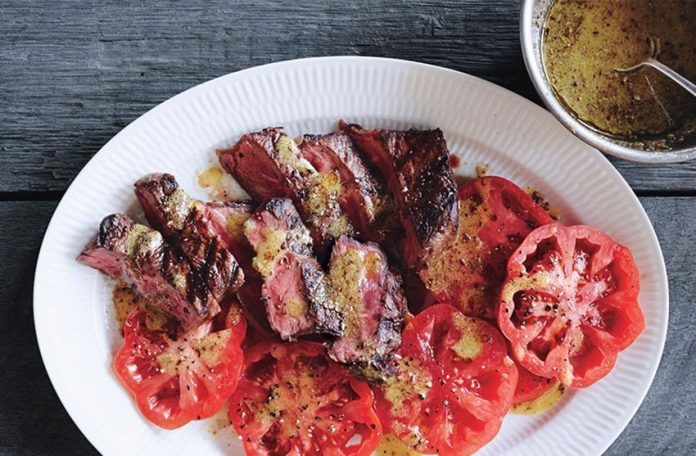It’s full-on tomato season in Sinaloa on the west coast of Mexico where I live. Here, tomatoes are the No. 1 commercial crop, and are even part of the state’s license plate. The vast majority, though, are plum tomatoes – not my favorite.
Bred less for flavor and more for easy shipping and consistent appearance, Mexico’s plum tomatoes are disappointing to any serious tomato lover. Actually, “modern” commercial tomatoes don’t have the natural sugars or essential umami flavor that makes the fruit taste so good and work so well in so many dishes. (Umami is why even something as basic as catsup adds so much to something as simple as fried potatoes.)
Sometimes you can find cherry, grape or a Beefsteak variety in a grocery or big-box store, but their flavors can’t compare to “real” tomatoes picked fresh and plant-ripened.
Lucky for me, the local farmers market has a wonderful array of Heirloom, cherry and other tomatoes in a rainbow of colors and many shapes and sizes. For the next few months, I’ll revel in this abundance. My Missouri-farm-girl mom instilled in me her love of fresh-from-the-garden tomatoes, and one of my fondest childhood memories is being sent outside before dinner to pick tomatoes, corn, zucchini, string beans, basil and mint.
Tomatoes are the most popular fruit in the world, with more than 188 million tons produced in 2019. (In case you’re wondering, bananas are next, followed by apples, oranges and watermelon.) But that wasn’t always the case. Until the mid-1800s, people in the U.S.A. considered them poisonous, because the plant is in the nightshade family. On the other side of the Atlantic, though, the French, Spanish and Italians were eating “love apples.”

The word “tomato” comes from the Spanish tomate (“fat thing”), originating from the Náhuatl word tomatl, “the swelling fruit.” The Aztecs cultivated tomatoes to be bigger and sweeter, calling the new species xitomatl – pronounced jitomate – “fat water with navel.” Spanish conquistadors brought tomatoes – then small and yellow – to Europe in the 1500s. Tomato recipes were first published in Naples in 1692, although they apparently came from Spain.
Do make some basic salsa – pico de gallo is so easy, there’s no reason not to. Chop tomatoes, onions, half a jalapeño (or more!), some cilantro, fresh lime juice, a pinch of salt and voila! (Using just yellow tomatoes will make your salsa a conversation piece as well as delicious.) If you like, add some fruit: mango, papaya, pineapple, even banana. Letting it sit, refrigerated, for an hour or so will blend the flavors.
Cherry Tomato Vinaigrette
Use this as a sauce over salads, omelets, savory French Toast or any white fish.
- 1 pint cherry tomatoes
- 3 Tbsp. olive oil, divided
- 1 shallot, finely chopped
- 1 Tbsp. (or more) red wine vinegar
- Salt & freshly ground pepper
- 2 Tbsp. chopped fresh chives
Cut half of cherry tomatoes in half. Heat 1 Tbsp. oil in medium saucepan over medium heat. Add shallot and cook, stirring, until softened, about 4 minutes. Add halved and whole tomatoes and cook, stirring occasionally, until juices release, 4–6 minutes. Mash some of tomatoes with a fork; add 1 Tbsp. vinegar and remaining 2 Tbsp. oil; season with salt and pepper. Serve warm or room temperature. Add chives just before serving.
Skirt Steak with Toasted Spice Vinaigrette
- 1½ pounds flatiron or skirt steak, cut into 4 pieces
- 1Tbsp. olive oil + more
- Salt & pepper
- 4 beefsteak or heirloom tomatoes, sliced ½” thick
For vinaigrette:
- 1 tsp. each coriander, cumin and fennel seeds
- ¼ cup olive oil
- 2 Tbsp. white vinegar
- 1 tsp. Dijon mustard
- Salt & freshly ground black pepper
To make vinaigrette: Toast coriander, cumin, and fennel seeds in a dry small skillet over medium heat, tossing, until fragrant, about 3 minutes. Let cool, then mince. Whisk with oil, vinegar and mustard in a small bowl; season with salt and pepper. Prepare grill for medium-high heat. Rub steak with a bit of oil; season with salt and pepper. Grill about 4 minutes per side for medium-rare. Let cool 5 minutes before slicing against the grain. Serve steak on top of tomatoes with vinaigrette spooned over.

Grilled Salsa Roja
Although a real grill will give a better flavor, this can be done in a toaster or regular oven set to broil.
- 8 plum tomatoes, cored
- ½ medium white onion
- 4 serrano chiles
- 3 garlic cloves, peeled
- 1 cup packed cilantro leaves
- Kosher salt
Prepare grill for high heat. Grill tomatoes, onion and chiles, turning occasionally, until lightly charred and fragrant, about 4 minutes for chiles and 6–8 minutes for tomatoes and onion. Let cool, then pulse everything in a blender or food processor until mostly smooth with a few small pieces. Add salt to taste. Cover and chill. –Bon Appetit magazine
Tomato Watermelon Salad
A refreshing and surprisingly delicious combination!
- About 4 lbs. chilled seedless watermelon, peeled and cut into 1-inch cubes
- 3 large Heirloom tomatoes, seeded and cut into 1-inch cubes, or 2 cups cherry tomatoes, halved
- 1 onion, thinly sliced
- 3 Tbsp. chopped fresh mint
- 1 cup crumbled feta cheese
- 1 tsp. salt
Gently toss watermelon, tomatoes, onion and mint in a large bowl. Add feta, season with salt, and gently toss again. –Allrecipes.com
Baked Tomatoes
Use atop pasta, in a sandwich, as a side dish.
- Olive oil
- 1 large tomato, in ½-inch-thick slices
- 1 sprig fresh rosemary, leaves stripped, finely chopped
- 1 clove garlic, minced
- Salt & pepper to taste
Preheat oven to 350 degrees. On oiled baking sheet, arrange tomato slices. Sprinkle rosemary and garlic over tomatoes and brush or drizzle with olive oil; season with salt and pepper. Bake in preheated oven until tomatoes are tender, 5 to 10 minutes.
Janet Blaser of Mazatlán, Sinaloa, has been a writer, editor and storyteller her entire life and feels fortunate to write about great food, amazing places, fascinating people and unique events. Her work has appeared in numerous travel and expat publications as well as newspapers and magazines. Her first book, Why We Left: An Anthology of American Women Expats, is available on Amazon. Contact Janet or read her blog at whyweleftamerica.com.
